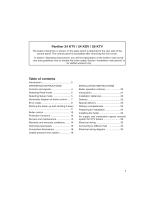P2_GEPARD_installer manual_ work basis_EN_02 - 03/10 - protherm
- 4 -
INTRODUCTION
and the European Directive 89/336/EEC on electromagnetic
compatibility.
The appliance is also approved according to the European
norms EN 677, EN 625, EN 60335-01, EN 50165, EN 55014,
EN 61000-3-2 and EN 61000-3-3.
In order to operate and handle the boiler in accordance with
the purpose for which it is designed in actual conditions of use
(hereafter referred to only as use), it is necessary to abide also
by additional conditions – the most essential of which (i.e. those
which must not be omitted) are found in the following regulatory
documents:
- in the design area: STN 06 0310 and STN 06 0830;
- in the fi re safety area: STN 92 0300;
- for installation and fi tting (and repairs): STN EN 1755 or STN
38 6460, as applicable STN 38 6462, Decree no. 48/1982
Coll. (as amended by the later prescriptions) and the binding
occupational health regulations;
- in time of running and operation: STN 38 6405;
- in the area of discharge of combustion gases and air infl ow
STN EN 483, company material – “catalogue of dual piping for
discharge of combustion gases and infl ow of combustion air
designated for type C gas appliances, i.e. in closed “TURBO”
version.
Local Regulation2.4.2
The boiler is designated for operation within the normal AA5/
AB5 environment in compliance with STN 33 2000-3 and
STN 33 2000-5-51 (i.e. a temperature range of 5 – 40°C,
temperature-dependent humidity to a max. of 85%).
PANTHER boilers are suitable for the conditions of zones 1, 2
and 3, in rooms with a bath or shower and in washing areas as
set out in STN 33 2000-7-701; they may not be installed in zone
0 (Fig.8). Before installation in the areas mentioned, protection
against electric shocks must be provided for according to the
same norms.
The boiler complies with Ministry of Health Decree No 13/1977
Coll., i.e. on noise, for installation in residential and public
areas.
The boilers are built to operate with heating water, in
compliance with STN 07 7401. (Above all, the water must never
be acidic, i.e. its pH must be higher than 7 and it should have
minimal carbonate hardness.)
The requirements regarding the characteristics of domestic
water are set out in STN 83 0616 (potable water STN 75
7111). With regards to water with total material concentrations
of calcium and magnesium greater than 1.8 mmol/l, further
“non-chemical“ measures against scale deposits (e.g. operation
of magnetic water treatments in combination with settling
equipment) are advisable.
Silting up of the boiler with contaminants from the heating
system or the settling of boiler scale on these disturbances, or
on induced disturbances (e.g. silting up of the exchanger, pump
breakdowns) are not covered by the boiler warranty.
The distance from fl ammable materials (e.g. PVC, fi breboard,
polyurethane, synthetic fi bres, rubber etc.) must be suffi cient to
keep the surface temperature of these materials below 80°C.
The minimum working (unhindered) space in close proximity
to the boiler must be such that the boiler can be worked with
easily and safely with bare hands and with the usual hand tools;
we recommend a minimum distance of 300 mm from up and
under, 10 mm from side and a minimum of 600 mm in front of
the boiler.
CH (heating) + HW (hot water) -
The GEPARD boiler (model MTV and MOV) supplies both
central heating and hot water for the home.
Non-condensing boiler with exhaust vented to a chimney -
Model MOV must be fi tted to a ventilation system (chimney).
The boiler comes equipped with a safety device that shuts off
the gas feed if the chimney becomes blocked.
Non-condensing boiler with forced extraction of exhaust. -
The MTV model is gas models fi tted with a ventilation system
for the intake of air and the venting of exhaust. Thanks to this
ventilation system, the heater can be installed in any space.
If the ventilator fails or if the chimney becomes blocked, the
pressure switch shuts down the heater.
The boiler must be installed and commissioned by a qualifi ed
technician. This ensures proper installation and operation
in compliance with valid norms. If any maintenance, repair
or adjustments concerning the gas are needed, a qualifi ed
technician must be called.
























